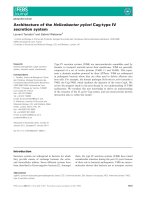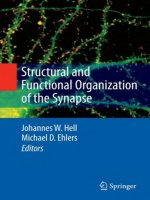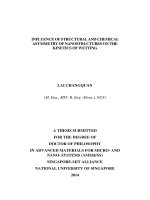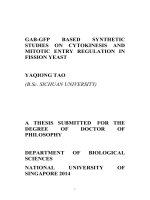Structural and functional studies on type III and type VI secretion system proteins
Bạn đang xem bản rút gọn của tài liệu. Xem và tải ngay bản đầy đủ của tài liệu tại đây (8.34 MB, 169 trang )
STRUCTURAL AND FUNCTIONAL STUDIES ON
TYPE III AND TYPE VI SECRETION SYSTEM PROTEINS
JOBICHEN CHACKO
(M Sc Agriculture)
A THESIS SUBMITTED FOR THE DEGREE OF
DOCTOR OF PHILOSOPHY
DEPARTMENT OF BIOLOGICAL SCIENCES,
FACULTY OF SCIENCE,
NATIONAL UNIVERSITY OF SINGAPORE
2008
ii
To my dear parents
iii
ACKNOWLEDGEMENTS
This thesis is the most significant scientific accomplishment in my life so far and it is my
pleasure to thank all those who made this possible and supported me in one way or other.
First and foremost I would like to thank Almighty God for blessing me with the
opportunity to complete my PhD studies.
I am grateful to my PhD supervisor, Assoc Prof Jayaraman Sivaraman. With his
enthusiasm, inspiration and great efforts to explain things clearly and simply, he helped
me understand what crystallography is. Without his patience and help, the structure of this
thesis would not have been possible.
I am also indebted to my co-supervisor A/P Leung Ka Yin for his enthusiasm, support,
sincerity and hard work.
I am extremely grateful to Prof Adrian Compoy for analysing the ITC data, A/P Markus
Wenk and Dr Aaron Fernandis for mass spectrometry and lipid identification experiments,
Prof Ilan Rosenshine and Dr Henry Mok for helping in manuscript preparation.
I am also thankful to Dr Li Mo, Dr Zheng Jun, and Gal Yerushalmi for all their help. I
would like to thank Dr Anand Saxena and Dr J Seetharaman who helped me during my
data collection at National Synchrotron Light Source, USA. I acknowledge the services
iv
provided by Protein and Proteomics Centre (NUS) and thank Mr Sashikant Joshi for all
his help.
I thank Dr Liang Zhao-Xun (SBS, NTU) and Haiwei SONG (IMCB, Singapore) for
allowing me to use the analytical ultra centrifugation facilities.
I would like to thank all my lab mates for their help and support especially, Yvonne,
Lissa, Sunita and Rajesh.
My sincere thanks to A/P K Swaminathan and all members of Structural Biology Lab 4,
especially Shiva for their support and help.
I am indebted to my peers at NUS for providing a stimulating and fun environment in
which I could learn and grow. I am grateful to all my friends especially Dileep
Vasudevan, Dileep G R and Jinu Paul.
I offer my special thanks to my parents, who constantly encouraged me
throughout my life in all my endeavors. Without their support this work would not have
been possible. I am also thankful to my sisters and their families for their support.
I am also indebted to all my family friends and relatives in Singapore for their help and
support during my stay.
Finally a big THANK YOU to Rose, my wife.
The NUS research scholarship, which supported my research and
stay in Singapore, is greatly acknowledged.
Thank you all.
v
Table of contents
Page No:
Acknowledgements iii
Table of contents v
Summary ix
List of tables xii
List of Figures xiii
List of abbreviations xvi
Publications xx
Chapter 1: General Introduction
1.1 Host Pathogen Interaction 2
1.2 Pathogenicity islands 3
1.3 Protein Secretion System 6
1.4 Sec system 8
1.5 Type I Secretion System 9
1.6 Type II Secretion System 10
1.7 Type III Secretion System 12
1.8 Type IV Secretion System 26
1.9 Type V Secretion System 27
1.10 Type VI Secretion System 29
1.11 Aim of this thesis 36
vi
Chapter 2: Structure of GrlR and the implication of its EDED 37
motif in mediating the regulation of type III secretion system in
enterohemorrhagic Escherichia coli (EHEC)
2.1 Introduction 38
2.2 Materials and Methods 41
2.2.1 Plasmid and strain construction 41
2.2.2 Purification and crystallization. 42
2.2.3 Data collection, structure solution and refinement 43
2.2.4 In vitro pull-down assay 44
2.2.5 Analytical ultra centrifugation 45
2.2.6 MALDI-TOF MS and MS/MS analysis 45
2.2.7 Circular dichroism spectrometry 46
2.2.8 Extracellular proteins isolation and assay 46
2.3 Results 47
2.3.1 Characterization of GrlR 47
2.3.2 Structure of GrlR 51
2.3.3 Dimers of GrlR 57
2.3.4 EDED Motif Is Essential for the Recognition of GrlA 60
2.3.5 Regulatory Function of GrlR Is Mediated by EDED Motif 63
2.4 Discussion 65
Chapter 3: Structural Basis for the Lipid Recognition of GrlR, 67
a Locus of Enterocyte Effacement Regulator
3.1 Introduction 68
3.2 Materials and methods 69
3.2.1 Protein purification and Crystallization 69
vii
3.2.2 Data collection, structure solution and refinement 70
3.2.3 Isothermal titration calorimetry 71
3.2.4 Lipid extraction 72
3.2.5 Mass spectrometry analysis 72
3.3 Results 73
3.3.1 GrlR has a lipocalin like fold 73
3.3.2 Isothermal Titration Calorimetric studies 77
3.3.3 Structure of GrlR Lipid complex 80
3.3.4 Mass spectrometry analysis to identify the physiological lipid 86
species bound to GrlR
3.4 Discussion 91
Chapter 4: Structural basis for the secretion of EvpC: a key type VI
secretion system protein from Edwardsiella tarda 95
4.1 Introduction 96
4.2 Materials and Methods 98
4.2.1 Plasmid and strain construction 98
4.2.2 Purification and crystallization 98
4.2.3 Data collection, structure solution and refinement 99
4.2.4 In-vitro pull down assay 99
4.2.5 Analytical Ultra centrifugation 100
4.2.6 MALDI-TOF MS and MS-MS Analysis. 100
4.2.7 Secreted proteins isolation and assay 101
viii
4.3 Results 101
4.3.1 Characterization of EvpC 101
4.3.2 Overall structure 106
4.3.3 Sequence and structural homology 109
4.3.4 Oligomerization 111
4.3.5 Interaction of EvpC with other E tarda T6SS secreted proteins 116
4.3.6 Identification of key residues for EvpC function 119
4.4 Discussion. 122
Chapter 5. Conclusion and Future Directions. 123
References 128
Appendices 147
ix
Summary
Transport of proteins across the bacterial cell envelope is a basic function
performed by bacteria. The secretion pathways used for the transport of proteins are
known as secretion systems. Secreted proteins are involved in various functions such as
biogenesis of the cell envelope, motility and intercellular communication. To date, six
types of secretion systems have been identified in gram-negative pathogenic bacteria. A
detailed introduction to bacterial secretion systems in gram-negative bacteria is given in
chapter1.
Enterohemorrhagic Escherichia coli (EHEC) is a common cause of severe
hemorrhagic colitis. EHEC’s virulence is dependent upon a type III secretion system
(T3SS) encoded by 41 genes. These genes are organized in several operons that are
clustered in the locus of enterocyte effacement (LEE). Most of the LEE genes, including
grlA and grlR, are positively regulated by Ler, and Ler expression is in turn positively and
negatively modulated by the proteins GrlA and GrlR, respectively. However, the
molecular basis for the GrlA and GrlR activity is still elusive. In chapter 2 of this thesis,
we report the crystal structure of GrlR at 1.9 Å resolution. It consists of a typical β-barrel
fold with eight β-strands containing an internal hydrophobic cavity and a plug-like loop
on one side of the barrel. Furthermore, a unique surface-exposed EDED (Glu-Asp-Glu-
Asp) motif is identified to be critical for GrlA–GrlR interaction and for the repressive
activity of GrlR.
x
GrlR adopts the typical lipocalin fold, which comprises an eight stranded β-barrel
followed by an α-helix at the C-terminus. Lipocalins are a broad family of proteins with
diverse functions. They are present in eukaryotes as well as gram-negative bacteria. In
chapter 3 of this thesis we report the structure of lipid-GrlR complex and the details of the
binding of a lipid to recombinant GrlR as verified by isothermal titration calorimetry.
Based on these results we identified glycerophosphatidyl phosphatidic acids and
glycerophosphatidylethanolamines as potential lipid ligands of GrlR. In addition, we
identified an endogenously bound lipid species to GrlR by electrospray ionization mass
spectrometry. Our studies demonstrate the hitherto unknown lipid binding property of
GrlR. We speculate that this property of GrlR may help to anchor and orient GrlR on
membrane to facilitate its interaction with the positive regulator GrlA.
The type VI secretion system (T6SS) is a recently identified secretion system used
by gram-negative bacteria to inject virulence proteins into host cells. The T6SS cluster in
Edwardsiella tarda is named as Evp (Edwardsiella virulence protein) and it contains 16
different genes that are classified into intracellular apparatus proteins, secreted proteins
and a group of proteins non-essential for T6SS. It has been shown that the secretion of the
apparatus protein Hcp1 from Pseudomonas aeruginosa, a close homolog of EvpC, is an
essential characteristic of a functional T6SS. Here we report the crystal structure of EvpC
from E. tarda refined at 2.8 Å resolution. EvpC is comprised of a loose β-barrel domain
with extended loops. We speculate that similar to its homolog Hcp1, EvpC can form a
hexameric ring with a diameter of 40Ǻ that is capable of transporting small proteins and
ligands. Analytical ultra centrifugation studies on the oligomerization state of EvpC
showed that depending on concentration, EvpC can exist as both dimer and hexamer in
xi
solution. Structure based mutational studies on EvpC have identified the critical residues
at the N-terminal region that are essential for the function of this protein.
Secretion systems in pathogenic bacteria play a major role in delivering virulence
proteins into host cells. Proteins associated with a secretion system are new targets for
potential drugs and vaccines, which can prevent diseases by impairing essential virulence
properties. Our studies broaden the understanding of the structure, function and assembly
of protein secretion system, particularly the type III and VI secretion systems in gram-
negative bacteria which will ultimately aid in drug development.
xii
List of tables
Page no:
Table 1.1 The characteristics of certain pathogenic bacteria, which use T3SS
for delivering the effector proteins. 15
Table 1.2 Some features of T6SSs in various bacteria 31
Table 2.1 The bacterial strains and plasmids used in this study 42
Table 2.2 Crystallographic data and Refinement Statistics 53
Table 3.1 Structural homologue of GrlR with lipid binding proteins (based on DALI) 75
Table 3.2 Data collection and refinement statistics 83
Table 4.1 Data collection and refinement statistics. 107
Table 4.2 Strains and plasmids used in this study. 120
Table 4.3 EvpC mutants used for extra-cellular protein secretion assay. 120
xiii
List of Figures
Page no:
Figure: 1.1 General structure of a Pathogenicity Island 5
Figure: 1. 2 Type I–V secretion systems in Gram-negative bacteria 7
Figure: 1.3 Model of pilus-mediated secretion via the type II secretion system 11
Figure: 1.4 The Type Three Secretion System 14
Figure: 1.5 Overall architecture of the Type III secretion apparatus (T3SA) 16
Figure: 1.6 Genes involved in EHEC pathogenesis 22
Figure: 1.7 T3SS effector functions of pathophysiologic importance 24
Figure: 1.8 Schematic overview of the type V secretion systems 28
Figure: 1.9 Schematic representation of a T6SS 30
Figure: 2.1 Locus of enterocyte effacement (LEE) 39
Figure: 2.2 Model for the regulation of LEE genes in A/E pathogens 40
Figure: 2.3 SDS-PAGE showing the expression of GrlR 47
Figure: 2.4 Profile of size-exclusion chromatographic purification of GrlR 48
Figure: 2.5 Dynamic light scattering profile of GrlR 49
Figure: 2.6 Mass spectrometry profile of GrlR 50
Figure: 2.7 Crystal of GrlR obtained by vapor batch method with PEG3350 51
and ethylene-glycol as precipitants
Figure: 2.8 Overall Structure of GrlR with Bound Ligand 52
Figure: 2.9 Ribbon diagram of GrlR dimer 54
xiv
Figure: 2.10 Stereo View of the β-Barrel and the Bound ligand 55
Figure: 2.11 Stereo View of the β-Barrel and the Bound ligand. 57
Simulated annealing Fo-Fc omit map
Figure: 2.12 Sedimentation co-efficient data for GrlR 58
Figure: 2.13 Velocity data for GrlR. 59
Figure: 2.14 The Electrostatic Surface Potential of GrlR Dimer 59
Figure: 2.15 In Vitro Pull-Down Assay 62
Figure: 2.16 In Vitro Pull-Down Assay 62
Figure: 2.17 Circular dichroism profile for GrlR native and mutants 63
Figure: 2.18 General Secretion Profile of EHEC EDL933 Harboring
pSA10-grlR and Expressing Wild-Type and Mutants of GrlR 64
Figure: 3.1 Sequence alignment of GrlR with major lipocalins. 76
Figure: 3.2 Superposition of GrlR with major lipocalins. 77
Figure: 3.3 ITC data for the 25°C titration of lipid (HHGP) into GrlR. 79
Figure: 3.4 Overall structure of GrlR with bound lipid (HHGP) 84
Figure: 3.5 Simulated annealing Fo-Fc omit map in the pore region of GrlR. 85
Figure: 3.6 Loop arrangements in GrlR 86
Figure: 3.7 Comparison of profiles between uninduced and induced Ni-NTA extracts 88
Figure: 3.8 Lipid profile using mass spectrometry 89
Figure: 3.9 Basic structure of phosphatidylglycerol and phosphatidylethanolamine 90
Figure: 3.10 MRM based quantification of lipids. 91
xv
Figure: 4.1
SDS-PAGE showing the expression of EvpC.
102
Figure: 4.2
Profile of size-exclusion chromatographic purification of EvpC 102
Figure: 4.3 Dynamic Light Scattering results of purified EvpC. 103
Figure: 4.4
Mass spectrometry profile of EvpC
104
Figure: 4.5
Crystal of EvpC
105
Figure: 4.6 Ribbon diagram of EvpC dimer 105
Figure: 4.7 Ribbon diagram of EvpC hexamer 108
Figure: 4.8 Stereo view of the Fo-Fc electron density map 108
Figure: 4.9 Structural and sequence alignment of EvpC 110
Figure: 4.10 Analytical ultra centrifugation profile of EvpC after elution 112
Figure: 4.11 FPLC profile of EvpC which showing hexamer peak 113
Figure: 4.12 Analytical ultra centrifugation profile of EvpC showing dimer peak 114
Figure: 4.13 Analytical ultra centrifugation profile of EvpC showing hexamer peak 114
Figure: 4.14 Packing of the EvpC molecules in the crystal 115
Figure: 4.15 Electrostatic surface potential of EvpC hexamer 115
Figure: 4.16 Pulldown assay studies with EvpC and EvpP 117
Figure: 4.17 Gel filtration profile of EvpP protein along with standards 118
Figure: 4.18 Analytical ultra centrifugation profile of EvpP 118
Figure: 4.19 Secretion assay profile of EvpC wild type and mutants. 121
xvi
List of abbreviations
A adenine
Å angstrom (10
-10
m)
aa amino acid
A/E Attaching and effacing
ATP adenosine triphosphate
AU arbitrary unit
AUC analytical ultracentrifugation
BLAST Basic Local Alignment Search Tool
BME β mercaptoethanol
CCD charge coupled device
CNS crystallography and NMR system
DEAE diethyl aminoethyl
DLS dynamic light scattering
DNA deoxyribonucleic acid
dNTP deoxyribonucleotide triphosphate
DTT dithiothreitol
EDTA ethylenediamine tetraacetic acid
FPLC fast performance liquid chromatography
xvii
Hepes 4-(2-hydroxyethyl)-1-piperazineethanesulfonic acid
IPTG isopropylthogalactoside
ITC isothermal titration calorimetry
kT unit of energy
(product of Boltzmann constant k and temperature T)
LB Luria-Bertrani
LEE Locus of enterocyte effacement
LPA lysophosphatidic acid
mA milli ampere
MAD multiwavelength anomalous dispersion
MALDI-TOF Matrix Assisted Laser Desorption Ionization –Time of
Flight
MD molecular dynamics
kDa thousand Daltons
MPD 2-methyl-2, 4-pentanediol
MS mass spectrometry
MW molecular weight
NCBI National Center for Biotechnology Information
NCS non crystallographic symmetry
Ni-NTA nickel-nitrilotriacetic acid
nm nanometer
xviii
NMR nuclear magnetic resonance
OD optical density
ORF open reading frame
PAI Pathogenicity island
PCR polymerase chain reaction
PEG polyethylene glycol
PolydIndx polydispersityindex
PVDF polyvinylidene difluoride
rmsd root mean square deviation
rpm Revolutions per minute
rRNA ribosomal RNA
S Svedberg unit (10
-13
s)
SAD single wavelength anomalous dispersion
SDS-PAGE sodium dodecyl sulfate - polyacrylamide gel electrophoresis
Se-Met/SelMet seleno-L-methionine
TCA trichloroacetic acid
WT wildtype
AMINO ACIDS
Ala (A) alanine
Arg (R) arginine
xix
Asn (N) asparagine
Asp (D) aspartic acid
Cys (C) cysteine
Gln (Q) glutamine
Glu (E) glutamic acid
Gly (G) glycine
His (H) histidine
Ile (I) isoleucine
Leu (L) leucine
Lys (K) lysine
Met (M) methionine
Phe (F) phenylalanine
Pro (P) proline
Ser (S) serine
Thr (T) threonine
Trp (W) tryptophan
Tyr (Y) tyrosine
Val (V) valine
xx
Publications
1) Jobichen C, Li M, Yerushalmi G, Tan YW, Mok YK, Rosenshine I,
Leung KY, Sivaraman J. 2007. Structure of GrlR and the implication of its
EDED motif in mediating the regulation of type III secretion system in
EHEC. PLOS Pathogens 3: e69.
2) Jobichen C, Aaron Zefrin Fernandis, Adrian Velazquez Campoy, Leung
Ka Yin, Yu-Keung Mok, Markus R Wenk and J Sivaraman. 2009. GrlR, a
Locus of Enterocyte Effacement Regulator, Is a Lipid Binding Protein
(Biochemical Journal 19 February 2009).
3) Jobichen C, Li Mo, Zheng Jun, Yu-Keung Mok, Leung Ka Yin, and J
Sivaraman. 2009. Structural and functional studies on EvpC, a Type six
secretion system protein. (Manuscript submitted).
Chapter I
General Introduction
2
1.1. Host-Pathogen Interaction
The interaction between bacterial pathogens and their host such as humans,
animals and plants is an important area of study in microbiological research. The findings
that emerge from these studies will aid drug development, as well as early diagnosis and
identification of pathogenic diseases. Host-pathogen interactions may be symbiotic or
pathogenic. These interactions can cause a wide variety of responses in the host cell. The
same pathogens can cause mild, sub-lethal or lethal infections, depending on the host. The
host immune response is the primary response against any pathogenic infection and it uses
a wide variety of mechanisms to neutralize and remove the pathogenic bacteria. The
pathogens also employ a wide variety of techniques to evade the host response. One of the
major weapons used by pathogens against the host is their virulence proteins, which are
capable of subverting the host immune response.
The genes that are responsible for producing virulence proteins are generally
clustered together in the genome and these gene clusters are known as pathogenicity
islands. The protein secretion system in bacteria plays a major role in delivering these
proteins into the host cell. Due to the presence of two membranes (outer membrane and
inner membrane), protein transport in gram-negative bacteria needs a complex secretion
system. Protein secretion systems in gram-negative bacteria have received special
attention due to this complexity. An overview of the pathogenicity islands (PAIs) and
various secretion systems employed by gram-negative bacteria are given below.
3
1.2. Pathogenicity Islands (PAIs)
PAIs are groups of genetic elements present in the genome of a pathogenic
organism and play a major role in the development of disease and virulence
.
PAIs were
discovered by Jorg Hacker (Knapp et al., 1986; Hacker et al., 1990). DNA fragments
consisting of more than one virulence gene were reported earlier and they were known as
virulence blocks (High et al., 1988; Hacker, 1990). The first report of pathogenicity DNA
islands came after the loss of two linked virulence gene clusters by a single deletion event
in Escherichia coli strain 536 (Hacker et al., 1990; Blum et al., 1994). Hacker and co-
workers generated a nonpathogenic strain of E. coli by deleting the PAI (Hacker et al.,
1990). The size and genetic structure of these E. coli PAIs were studied in detail (Hacker
et al., 1983; Knapp et al., 1985; Hacker et al., 1990).
Schmidt and Hensel (2004) have described some of the genetic features of PAIs which are
as follows.
(i) One or more virulence genes are present in a PAI.
(ii) PAIs are present mainly in pathogenic strains of bacteria.
(iii) The nucleotide composition of the core genome is different from that of PAI.
(iv) Large genomic regions are covered by PAI.
(v) Generally, PAIs are located close to tRNA genes.
(vi) PAIs are often flanked by direct repeats (DR) and they are associated with mobile
genetic elements. Direct repeats are small DNA sequences (16 to 20 bp) with a perfect or
nearly perfect sequence repetition.
(vii) When compared with normal mutations, those in PAIs are unstable and may get
deleted more frequently.
4
(viii) PAIs are sometimes heterogeneous due to the accumulation of different genetic
elements into the same chromosomal site. But in some cases, only one insertion is present
which may be more homogeneous.
In a single organism, PAIs can perform different functions according to the environmental
conditions. In E. coli, these pathogenicity islands help the bacterium to produce virulence
proteins as well as in adapting to various environmental conditions (Knapp et al., 1986;
Tauschek et al., 2002). For e.g; E. coli is involved in the development of diseases such as
diarrhea and hemolytic-uremic syndrome after colonizing in the large intestine, watery
diarrhea after colonizing in the small intestine and urinary tract infection after survival and
colonizing in the bladder.
Most of the PAIs are acquired by bacteria during evolution and in some species,
addition of this new gene cluster has resulted in the transformation of an avirulent species
to virulent species. These types of evolutionary changes usually take place at a slow pace
(normally a few million years), but in some bacteria e.g. Vibrio cholerae, a virulent strain
developed in less than 100 years from its avirulent form (Waldor and Mekalanos, 1996).
Another important character associated with PAI is that they provide resistance to
antibiotics as well as environmental changes. These PAIs also serve as markers to identify
new strains and species of pathogens. A schematic representation of a PAI is given in
Fig.1.1. The genes encoding the bacterial secretion system proteins are clustered in the
PAI. A detailed description of the major protein secretion systems present in gram-
negative bacteria is given in the next section.
5
Figure 1.1. General structure of a Pathogenicity Island. (A) Typical PAIs are distinct
regions of DNA that are present in the genome of pathogenic bacteria but absent in
nonpathogenic strains of the same or related species. PAIs are mostly inserted in the
backbone genome of the host strain (dark grey bars) in specific sites that are frequently
tRNA or tRNA-like genes (hached grey bar). Mobility genes, such as integrases (int), are
frequently located at the beginning of the island, close to the tRNA locus or the respective
attachment site. PAI harbor one or more genes that are linked to virulence (V1 to V4) and
are frequently interspersed with other mobility elements, such as IS elements (Isc,
complete insertion element) or remnants of IS elements (ISd, defective insertion element).
The PAI boundaries are frequently determined by direct repeats (DR, triangle), which are
used for insertion and deletion processes. (B) A characteristic feature of PAI is the G-C
content that is different from that of the core genome. This feature is often used to identify
new PAI. (This figure is adapted from Schmidt and Hensel, 2004)









